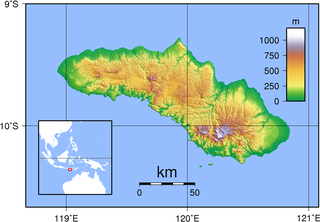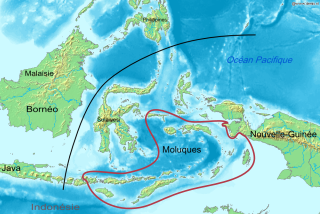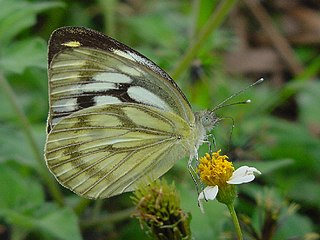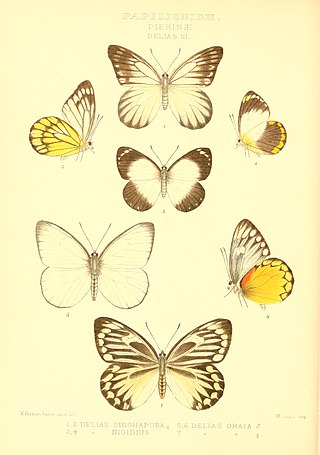
Sumba, natively also spelt as Humba, Hubba, Suba, or Zuba is an Indonesian island located in the Eastern Indonesia and administratively part of the East Nusa Tenggara provincial territory. Sumba has an area of 11,243.78 square kilometres, about the same size as Jamaica or Hawaii (Island). The population was 686,113 at the 2010 Census and 779,049 at the 2020 Census; the official estimate as of mid-2023 was 820,506. To the northwest of Sumba is Sumbawa, to the northeast, across the Sumba Strait, is Flores, to the east, across the Savu Sea, is Timor, and to the south, across part of the Indian Ocean, is Australia.

Sumbawa is an Indonesian island, located in the middle of the Lesser Sunda Islands chain, with Lombok to the west, Flores to the east, and Sumba further to the southeast. Along with Lombok, it forms the province of West Nusa Tenggara, but there have been plans by the Indonesian government to split the island off into a separate province. Traditionally, the island is known as the source of sappanwood, as well as honey and sandalwood. Its savanna-like climate and vast grasslands are used to breed horses and cattle, as well as to hunt deer.

Waingapu is the largest town in the eastern half of Sumba island, East Nusa Tenggara, Indonesia. It is the capital town of the East Sumba Regency.

The Central Malayo-Polynesian languages (CMP) are a proposed branch in the Malayo-Polynesian subgroup of the Austronesian language family. The languages are spoken in the Lesser Sunda and Maluku Islands of the Banda Sea, in an area corresponding closely to the Indonesian provinces of East Nusa Tenggara and Maluku and the nation of East Timor, but with the Bima language extending to the eastern half of Sumbawa Island in the province of West Nusa Tenggara and the Sula languages of the Sula archipelago in the southwest corner of the province of North Maluku. The principal islands in this region are Sumbawa, Sumba, Flores, Timor, Buru, and Seram. The numerically most important languages are Bima, Manggarai of western Flores, Uab Meto of West Timor, and Tetum, the national language of East Timor.

The Sumbawa Pony is a pony breed, named after the island on which they are bred, Sumbawa Island in Indonesia. This breed is very similar to the Sumba or Sandalwood Pony, a breed also developed in these islands, which came from crossing the native ponies on horses of Arabian breeding. The Sumbawa Pony descends from Mongolian Horses and ancient Chinese stock

The barred dove is a small dove that is native and endemic to the Lesser Sunda Islands in Indonesia. It is closely related to the zebra dove of southeast Asia and the peaceful dove of Australia and New Guinea.
Sumba Strait is a strait in Indonesia.

The Sumba roundleaf bat is a species of bat in the family Hipposideridae. It lives in Indonesia and East Timor. It is present on the islands of Sumba, Rote, Sumbawa, Flores, Semau, and Savu.

The Sape Strait or Sapie Strait is a strait connecting the Flores Sea to the Sumba Strait. It separates the islands of Sumbawa and Komodo. It joins the Indonesian provinces of West Nusa Tenggara and East Nusa Tenggara.

Cepora judith, the Orange Gull, is a butterfly of the family Pieridae. It has no common name, although a subspecies is referred to as the orange gull. It is found in south-eastern Asia.

Cepora is a genus of butterflies, commonly called gulls, in the family Pieridae. The genus contains about 20 species shared between the Indomalayan and Australasian realms.
The Bima language, or Bimanese, is an Austronesian language spoken on the eastern half of Sumbawa Island, Indonesia, which it shares with speakers of the Sumbawa language. Bima territory includes the Sanggar Peninsula, where the extinct Papuan language Tambora was once spoken. Bima is an exonym; the autochthonous name for the territory is Mbojo and the language is referred to as Nggahi Mbojo. There are over half a million Bima speakers. Neither the Bima nor the Sumbawa people have alphabets of their own for they use the alphabets of the Bugis and the Malay language indifferently.
Cepora temena is a butterfly in the family Pieridae. It is found in Indonesia.

Miletus leos is a butterfly in the family Lycaenidae. It is found in Asia.

The Sultanate of Bima, officially known as The Settlements and Lands of Mbojo, alternatively the Kingdom of Bima was a Muslim state in the eastern part of Sumbawa in Indonesia, at the site of the present-day regency of Bima. It was a regionally important polity which formed the eastern limit of Islam in this part of Indonesia and developed an elite culture inspired by Makassarese and Malay models. Bima was subjected to indirect colonial rule from 1669 to 1949 and ceased to be a sultanate in 1958.
The 1977 Sumba earthquake occurred approximately 290 kilometres (180 mi) south of Bima, Sumbawa, and beneath the Indian Ocean, at . With a moment magnitude of 8.3, the earthquake is notable for having an unusually great magnitude for a shock with a normal faulting focal mechanism. The shock occurred near the southern section of the Sunda Trench where several other tsunami-generating earthquakes have occurred. The earthquake was at the time the largest outer-rise earthquake ever recorded in Indonesia, and aftershocks along the trench extended about 130 kilometres (81 mi) eastward and 110 kilometres (68 mi) westward from the epicenter.

Delias oraia is a butterfly in the family Pieridae. It was described by William Doherty in 1891. It is found in the Australasian realm.
Charaxes elwesi is a butterfly in the family Nymphalidae. It was described by James John Joicey and George Talbot in 1922. It is endemic to Sumbawa and Sumba in the Indomalayan realm.

The Bimanese or Mbojo are an ethnic group of Indonesia that inhabits the eastern part of Sumbawa Island in West Nusa Tenggara province. With a population approaching a million people, they are the second largest ethnic group in West Nusa Tenggara.













